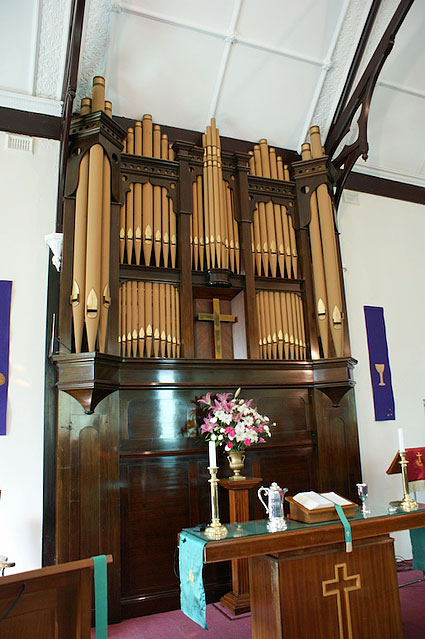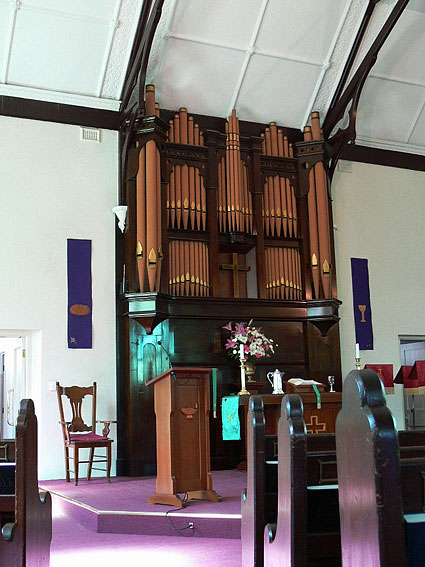Uniting (Methodist) Church
Smith Street, Walkerville
B 1921 W.L. Roberts. 2m, 17spst, 7c, el.pn.
Gt: 8.8.8.4.16.8.8. Sw: 8.8.8.4.16.8. Ped: 16.16.8.16.

Photo: Rodney Ford (Oct 2009)
As
early as 1841, Wesleyan Methodist services had begun in private homes in the
Walkerville area. In 1842, the
present site was purchased and a 50-seat church was erected by voluntary labour
the following year. Land for the
adjoining cemetery was acquired in 1849.
Initially singing was unaccompanied but with the advent of a new church
in 1855 came a harmonium. The pipe
organ did not arrive until 1921 as a memorial to the fallen of World War I.
This
church in Walkerville was the third of the Wesleyan Methodist denomination to
be organised in the colony. With
no musical instrument, the pitch for singing was set by the preacher. As hymn books were scarce and many of
the flock were illiterate, lines of the verses were first read and then sung. It is said that on one occasion a
preacher started four different tunes during the one hymn.1
The
cemetery is of interest. The
Trustees of the Wesleyan and Methodist Society purchased the land for the
adjoining cemetery on 8 May 1849 for the sum of £12, the first burial being on 10 April
1850. To be expected, the majority
of burials were Wesleyan, but there was a policy of allowing access to members
of other denominations. The last
recorded burial took place in May 1973.
Subsequently, the cemetery was closed, with 3,785 recorded burials
having taken place.2 Of
particular interest are the three German headstones in the south-west corner of
the site. They belong to the
Witkowski family, Jacob (1885), his wife Beata (1893), and adopted child
Pauline (1877). Witkowski imported
pipe organs.3
On
25 July 1854, the foundation stone of a new church building was set and “a
substantial and commodious edifice of stone with a neatly finished interior”
was opened on Sunday 29 April 1855.
A major attraction was a harmonium built by Mr Lilywhite, said to be the
first made in South Australia.4 A new reed organ was purchased and opened on 10 December
1894. Mr Warren played several
selections and Miss Lucy Stevenson sang.5
Moves
began in 1909 for the building of yet another, larger, church, and finally on
30 November 1912 the present building, to seat 300, was opened. The architect was the Revd T. Geddes
White.6
The
cessation of hostilities on the world stage frequently saw the erection of
memorials to the fallen. Though
memories often fade, the organ at Walkerville is a memorial to the men of the
church who had served in the First World War. The central plaque bears the names of 12 men who made the
supreme sacrifice. The organ was
opened free of dept largely through the untiring efforts of Mr Wilfred Hobba
who was organist for 30 years.7 Built by W.L. Roberts, it was opened and dedicated by
Brigadier-General S. Price Weir DSO VD on Sunday 27 November 1921 at the 11.00
am service.
On
the Tuesday following, a recital was given by Harold Parsons, Mus. Bac. The programme began with Mendelssohn’s Sonata
in C Minor, and was followed by
Lemare’s Caprice Oriental and
Wolstenholme’s Question and Answer, an Offertory on two Xmas Carols by Guilmant, the Choral Preludes Melcombe and Eventide by Parry, Starlight
and MDCXX of MacDowell, a
prelude of Debussy with the finale being the last movement of the Concerto
in B flat of Handel. Songs of
Gounod and Liddle given by Miss Hilda Simcock AMUA. and Mr E. Fairhurst
Derbyshire complemented the organ solos and the evening was rounded out with
the singing of the hymn “God is with us”.8
The
instrument was of interest for the provision of Swell Oboes at 16 and 8ft
pitch, and a Pedal Contra Dulciana 16, thought to be the first examples of such
stops provided on a two-manual organ built in Australia. The casework was elaborate, with two
outer circular towers containing three pipes and a slim central tower placed at
an upper level on either side of two flats, each of two storeys.
Original specification9
Builder William L. Roberts, Alfred Street,
Parkside, Adelaide : 27 November 1921
2 manuals, 16 speaking stops, tubular-pneumatic
action
|
GREAT ORGAN |
|
|
|
Open Diapason |
8 |
|
|
Clarabella |
8 |
|
|
Dolce |
8 |
A |
|
Principal |
4 |
|
|
Contra Oboe |
16 |
B |
|
Oboe |
8 |
B |
|
Swell Sub to Great |
|
|
|
Swell to Great |
|
|
|
Swell Octave to Great |
|
|
|
|
|
|
|
SWELL ORGAN |
|
|
|
Melodic Diapason |
8 |
|
|
Lieblich Gedact |
8 |
|
|
Viol d’Orchestre |
8 |
|
|
Suabe Flute |
4 |
|
|
Contra Oboe |
16 |
B |
|
Oboe |
8 |
B |
|
Tremulant |
|
|
|
Swell Sub |
|
|
|
Swell Super |
|
|
|
|
|
|
|
PEDAL ORGAN |
|
|
|
Bourdon |
16 |
C |
|
Contra Dulciana |
16 |
A |
|
Flute |
8 |
C |
|
Contra Oboe |
16 |
B |
|
Great to Pedal |
|
|
|
Swell to Pedal |
|
|
Compass 61/32
3 thumb pistons to Great
3 thumb pistons to Swell
Reversible thumb piston
for Swell to Great
Reversible thumb piston
for Swell to Pedal (disconnects Great to Pedal)
3 toe pistons to Great
(duplicates manual pistons)
3 toe pistons to Swell
(duplicates manual pistons)
1 toe piston for Grand
Organ
Reversible toe piston for
Great to Pedal
Balanced swell pedal
Electric motor and blower
(the latter manufactured by Ellis & Clark)
Detached drawstop console
At
some point, perhaps in the 1960s, the action was changed to electro-pneumatic
allowing the console to be moved away from its central position in front of the
pulpit. The reed stops have been
removed and alternative ranks substituted. In place of the Oboes there is a Fifteenth and on the Swell
an Aeoline. The Pedal Flute is
named Bass Flute and in place of the Contra Oboe is a Principal rank. L.S. Waters may well have done this
work, but needs verification. The
console was further moved in 1990.10
1
South Australian Methodist, 24 March 1944, p.2
2 Cemetery information from website www.walkerville.sa.gov.au
3 Witkowski was responsible for importing
at least two pipe organs, one of which is at Holy Trinity Lutheran Church
Nuriootpa (see entry); the other is at the monastic retreat of the Passionist
Fathers at Glen Osmond.
4
South Australian Methodist, op cit; also in Scales, M., John Walker’s
Village (1974), p.27 quoting Register 1 May 1855.
William Lillywhite was conductor of the North Adelaide Choral Society
and instructed singers using the Hullah system, Register 30 April 1855, p. 1.6; ibid., 21
December 1853, p. 3.6
5
Christian Weekly &
Methodist Journal, 28 December
1894, p.3
6 South Australian Methodist, 24 March 1944, p.2; T. Geddes White was born in
Victoria in 1863 and began his ministry in 1885. He died in 1946 and is buried in West Terrace Cemetery,
Adelaide: Methodist Church of
Australia Ministerial Index, ninth ed. (1961), p.206; see also: South
Australian Methodist, 26 July
1946, p.5; ibid., 2 August
1846, p.5
7 Pamphlet: Centenary Celebrations Walkerville Methodist Church
1844-1924, p.9
8
Opening and dedication of the
Memorial Organ Sunday November 27th 1921.
9 Ibid.
10 Changes noted D. Shield 1990

Photo: JRM (Oct 2009)